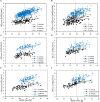Is Experimental Evolution of an Increased Aerobic Exercise Performance in Bank Voles Mediated by Endocannabinoid Signaling Pathway?
- PMID: 31191344
- PMCID: PMC6546880
- DOI: 10.3389/fphys.2019.00640
Is Experimental Evolution of an Increased Aerobic Exercise Performance in Bank Voles Mediated by Endocannabinoid Signaling Pathway?
Abstract
The level of physical activity achieved in a given situation depends on both physiological abilities and behavioral characteristics (motivation). We used a unique animal model to test a hypothesis that evolution of an increased aerobic exercise performance can be facilitated by evolution of motivation to undertake physical activity, mediated by brain endocannabinoid system. Bank voles (Myodes glareolus) from "aerobic" A lines selected for 22 generations for high swim-induced aerobic metabolism (VO2swim) achieved 65% higher "voluntary maximum" VO2swim than voles from unselected, "control" C lines. In C lines, VO2swim was 24% lower than the maximum forced-running aerobic metabolism (VO2run), while in A lines VO2swim and VO2run were practically the same. Thus, the selection changed both the aerobic capacity and motivation to exercise at the top performance level. We applied a pharmacological treatment manipulation to test a hypothesis that the endocannabinoid signaling pathway 1) affects the voles performance in the aerobic exercise trials, and 2) has been modified in the selection process. Administration of the CB1 receptor antagonist (Rimonabant) did not affect the level of metabolism, but administration of the endocannabinoid reuptake inhibitor (AM404) decreased VO2swim both in A and C lines (4%, p = 0.03) and tended to decrease VO2run (2%, p = 0.07). The significant effect of AM404 suggests the involvement of endocannabinoids in signaling pathways controlling the motivation to be active. However, the response to AM404 did not differ between A and C lines (interaction effect, p ≥ 0.29). Thus, the results did not provide a support to the hypothesis that modifications of endocannabinoid signaling have played a role in the evolution of increased aerobic exercise performance in our experimental evolution model system.
Summary statement: The results corroborated involvement of endocannabinoids in the regulation of physical activity, but did not support the hypothesis that modification of endocannabinoid signaling played a role in the evolution of increased aerobic exercise performance in our experimental evolution model.
Keywords: endocannabinoids; experimental evolution; motivation; physical activity; selective breeding; voluntary exercise.
Figures





References
-
- Adamczyk P., Gołda A., Mccreary A. C., Filip M., Przegaliński E. (2008). Activation of endocannabinoid transmission induces antidepressant-like effects in rats. J. Physiol. Pharmacol. 59 217–228. - PubMed
-
- Almeida V., Peres F. F., Levin R., Suiama M. A., Calzavara M. B., Zuardi A. W., et al. (2014). Effects of cannabinoid and vanilloid drugs on positive and negative-like symptoms on an animal model of schizophrenia: the SHR strain. Schizophr. Res. 153 150–159. 10.1016/j.schres.2014.01.039 - DOI - PubMed
LinkOut - more resources
Full Text Sources

